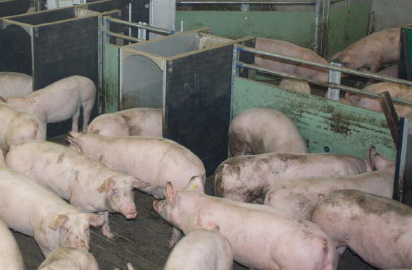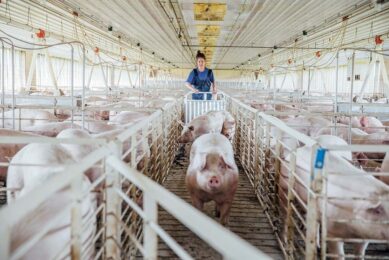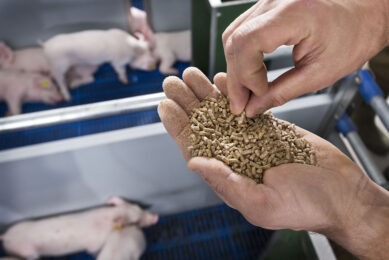Keeping an eye on every single finisher pig

In sheep and goat production, the system is already in use. In pig production, however, individual finisher identification has not been commonplace. Until this October – when the first finisher pig house with individual electronic ID was opened. Welcome to a whole new range of opportunities.
It is very hard, if not impossible, to explain the novelty of the Classens farm to anybody outside the pig business. “So pig farmers can now recognise, monitor, save and trace back growth data of each individual finisher pig? That sounds like the most logical thing on earth. Are you sure that is really new?”
Indeed it sounds very logical. And indeed, it doesn’t require rocket science to set up a system like that. Still, it has never become commonplace. Finisher pig farms all around the world provide their feed to batches of finisher pigs, send finishers off to the slaughterhouse in batches and clever traceability systems assure that the production location of a certain batch of pigs can be found. If any individual animal knowledge techniques are applied in professional pig production, they can be found in breeding. For sows, as carriers of any breeder’s capital, sophisticated individual feeding patterns are required. And since they usually serve a long time on a farm, sows are worth the expensive RFID ear tag investments.
For finisher pigs, however, the economic drive to know them individually, has simply never existed. That mentality is now about to change.
Castration
A first reason to take a closer look at each individual finisher pigs is related to recent developments with regard to castration in the EU. The European Union is heading towards a market in which castration no longer exists – as from 2018 all piglets ought to be kept ‘entire’. As any pig producer may know, however, raising boars and gilts is a completely different ballgame than castrates and gilts. For one, because the boars need a more specified nutrition, resulting in different growth curves; for another because sending overweight boars to slaughter is a reason to be penalised heavily. Keeping a closer eye on them is what should be done – solutions can either be separate housing or recognition on the basis of sex.
A second reason would be related to the price of ear tags, as they are coming down gradually, says Arno van Brandenburg, sales manager of Dutch livestock management systems manufacturer Nedap Agri. The company produces the sorting system with individual recognition, called Nedap Velos Sorting. Van Brandenburg says, “A couple of years ago, prices were up to €6 per tag – this is not affordable, especially when discounts are being given of €16 on some carcasses.
Now prices are €1.5 and we expect them to come down more.”A third reason follows from the second one – now it is affordable to monitor each individual finisher pig – why not do it? After all, a treasure trove of hitherto hidden knowledge suddenly comes to light. Toon Classens, 57, owner of the 4,600 finishing farm near Veulen, in the south of the Netherlands, shows a computer screen full of data, with growth curves of many pigs in a batch. Two of them clearly show a lower growth. Pointing to those, he says, “We can now see that two of them need a different approach – perhaps I’ll move them to a different section.”
Classens can think of a fourth reason why converting to a system like this is to be preferred – welfare-related. Often he received comments from work placement students with a non-pig background, noting that in their view the finishers had barely any room to stretch their legs. Classens said, “In the Netherlands it is fairly common to keep finishers in groups of 15-20. Towards the end of finishing I can imagine they get this idea. With this new sorting system, I keep the finishers in groups of approximately 250. They have exactly the same total space, but the pigs can now share this area.”
Farm
Toon Classens and his wife Tiny, 56, have been in pig production all their lives. In fact, Toon Classens’s father was in livestock production – and so are most of their children. In the 80s and early 90s, the Classens family ran a farrow-to-finish farm; nowadays the sections are split up between the family members. The breeder section is owned by their son Sjef, living only at a short distance away, and delivering 270 new grower pigs a week to his parents’ finishing site. Together all farms of the Classens family are united in the ‘Classens Groep’ cooperation.
The family set up allowed Toon Classens to probably be the first-ever professional pig farm to build a pig house with an individual finishing pig monitoring system. The pig house, which can house 2,440 finishers, opened in early October 2011. Toon Classens said, “We are still young enough to try – and we hope to learn to get the maximum out of the management system.”Knowing who breeds the pigs is pivotal in this approach, as all piglets individually need to be eartagged one extra time, after birth. Apart from the standard yellow eartag in their right ear, the females receive one electronic ear tag; the males receive one in their left ear. On the picture, the tags are green and yellow – this is about to change very shortly into pink for gilts and blue for boars – a novelty. These colours should allow everyone to discern between the sex very rapidly – even when workers from around the globe are employed.Classens farm is bigger than only this new finisher barn. Since 2004, on-site there has been a second, existing, ‘old-style’ finishing barn for 2,160 finishers, which will remain in business as usual. In addition, he also keeps horses as well as sheep.
Barns
The set-up in each of the ten sections in the new finisher barn ressembles conventional sorting management systems, which have been on the market for quite some time all over the world. When hungry, pigs need to go through a weighing sluice – and the animal is allocated entry to a feeding zone through one of three gates. What is different to conventional systems, however, is that determining the animal’s weight is only the beginning.
For it is no longer a pig going to a trough. The scanner in the sluice will read the animal’s ear tag – and a computer will know this is pig 1008 (see Figure 1) – female, born on June 6, weighing well over 100 kg at the moment. On average she is paying almost five visits to the trough every day, growing 1,050 kg/day at the moment.That is a growth curve above average, and pig 1008 notices the gate to its left will open, where it can enter a feeding zone with low energy feed. As soon as it has had enough, the way out is easy through a one-way gate.
The data acquired through the scanner will be stored on the Nedap Velos system, accessible through various computers on-farm, as well as a handheld device. This allows a producer both to zoom in onto an animal’s history and development, as well as to zoom out and to compare its performances to its penmates.
The three entry gates represent three sorting options, Van Brandenburg explains. Two gates lead to trough areas, one providing a high energy feed, the other providing a somewhat lower energy feed. And a third leads to an empty space – this could either be used for taking out the two slow-growers as described above, or for sex-based sorting before slaughter. All that Classens needs to do is open the pen door and the corridor behind him will serve as a perfect compartment.
In total, Classens has three diet formulations, which can be applied depending on the age and size of the batch.
Classens provides a starter meal for the first timeframe (25-40 kg), containing easily digetible proteins and energy sources, then an intermediate feed is provided (40-75 kg) and as from 75 kg the pigs receive a finishing feed. He can adjust the type of feed in each trough automatically.
Pioneering
The system has been put in place sincethe end of September, so definite comments as to growth figures and production results are hard to give. Toon Classens however does know that the new amount of available data may need some time to get used to.
He said, “All of a sudden, data are available that you always wanted to have but never used to have. Not sure if I am going to be able to interpret and use all the available data to its full extent.” Future opportunities, he knows, may only become bigger when other parties in the production chain would also acknowledge and embrace the possibilities of the approach of individual monitoring. But even without the active acknowledgement of ear tags by his slaughterhouse, the system may already offer advantages beyond the farm premises.
Classens hopes that individual sorting will allow him to achieve a better uniformity, resulting in better payments from the slaughterhouse.In addition, Classens is curious to know whether finishers can benefit from some privacy, and therefore in one of the pens, he followed the approach often used in group housed sows. Using frames he created semi-open compartments, where the finishers can lie down and find a quiet spot in case penmates may get unfriendly. The other pens do not have these compartments and it will remain to be seen in which pen the animals perform better.Still, aggressiveness and yes, mounting, is one of the other challenges Classens is facing, while finishing boars. Going through the finishing house then means bringing in a stick, gently fighting off many curious creatures trying to bite your ankles. Classens knows that the combination ‘gilts and boars’ therefore has to be a test phase. In case this would not work well, the solution is simple, Classens indicated – then the ‘old’ building will be allocated for boar production. PP
More pictures on this farm visit? See www.pigprogress.net /photo-gallery/
Individual finishing The concept of RFID-based individual finisher pig monitoring is being researched in other places in Europe as well. One major project, not related to the system described in the article, is called PigWise. This revolves around an ICT based tool that can be used to monitor performance and welfare of pigs at the individual level in order to detect problems at an early stage and hence preventing economical losses. Computer-aided analysis of individual animals’ data then enables to develop an early warning system for potential drops in performance or potential health problems. The research uses ear tags and antennas attached to feeders to gain knowledge about individual animals and their feeding patterns. It is hoped early detection can avoid early mortality, disease and lameness as well as a large weight range. Research partners of this project include the Flemish Institute for Agriculture and Fisheries Research (ILVO), Belgium; University of Göttingen, Germany; Katholieke Universiteit Leuven, Belgium; Engineering College of Aarhus, Denmark; Istituto Superiore Mario Boella (ISMB), Italy. |
Join 18,000+ subscribers
Subscribe to our newsletter to stay updated about all the need-to-know content in the pigsector, three times a week. Beheer
Beheer










 WP Admin
WP Admin  Bewerk bericht
Bewerk bericht